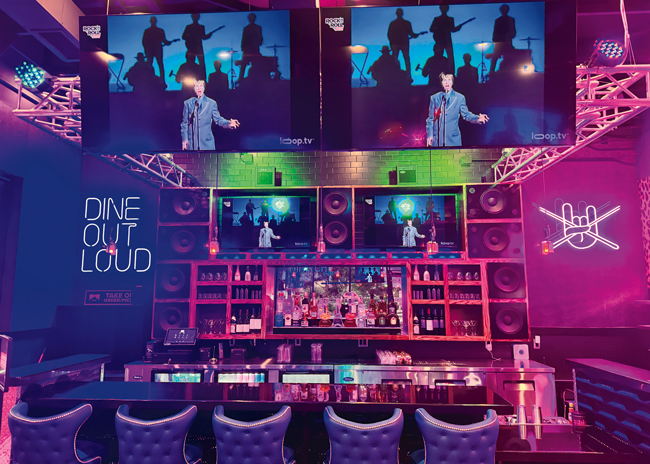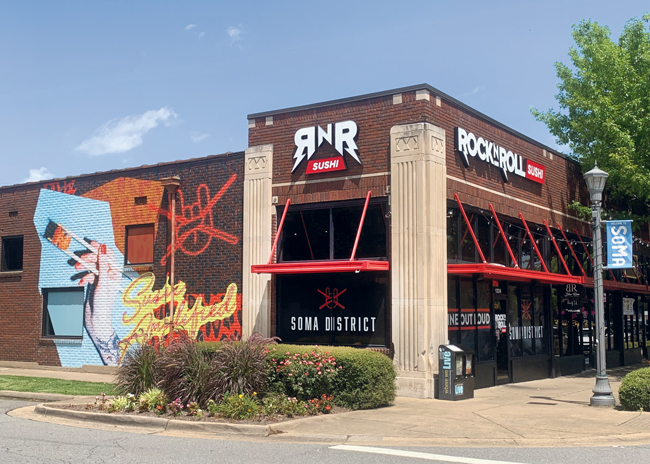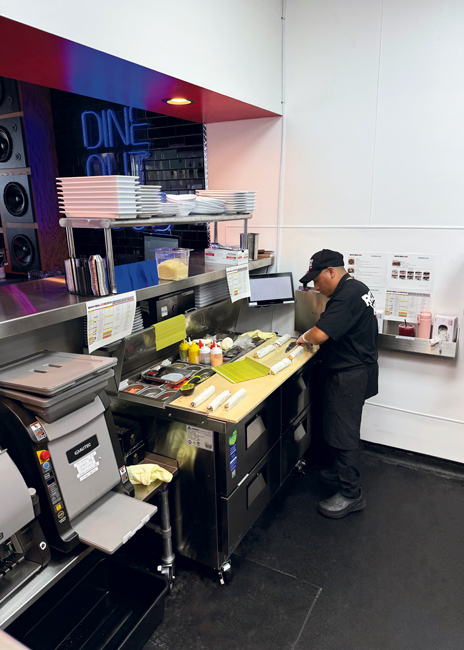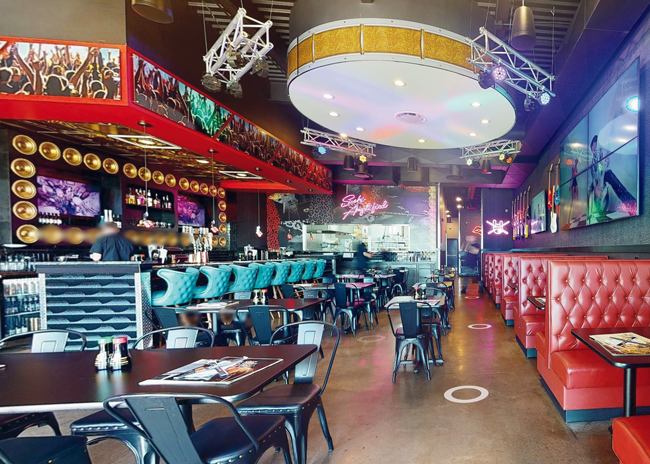This music-themed concept is succeeding by making sushi, which is often considered niche, accessible to everyone.
 Images courtesy of Rock n Roll Sushi Sushi might have gone mainstream in many cities, but for smaller markets, it can still be a little unfamiliar — even an oddity, in the eyes of some.
Images courtesy of Rock n Roll Sushi Sushi might have gone mainstream in many cities, but for smaller markets, it can still be a little unfamiliar — even an oddity, in the eyes of some.
Sushi concepts in these smaller towns have to clear extra hurdles. Not only do they face the challenges of every operator — labor, competition, real estate, rising supply costs — but they have to win the business of a public that is at least partly skeptical of sushi concepts.
One chain, though, has seemingly found a way to break through that skepticism and thrive selling sushi to markets ranging from 50,000 to 150,000 people. The answer: Make it familiar, and make it cool.
“We refer to ourselves as Americanized sushi. We think of ourselves as sushi for the masses,” says Craig LeMieux, CEO of Destin, Fla.-based Rock N Roll Sushi. “We’re there for everybody. It’s not a pompous environment of a sushi restaurant where you feel like you have to get dressed up. We’re very ‘come as you are.’ The construction worker and the CEO both feel comfortable coming and dining with us.”
Americanized, yes. And, through rock ‘n’ roll, cool. Cool enough, in fact, to hit more than 70 locations since its original opening in 2010. Cool enough to get acquired by Bold Restaurant Brands (owned by Tropical Smoothie Cafe founder Eric Jenrich) in 2020. And cool enough that the chain projects hitting 250 locations within the next five years.
What Is Rock N Roll?
The concept infuses the “rock” in Rock N Roll Sushi. Instead of being greeted by bonsai trees or water features, customers hear rock music playing on the restaurant’s speakers, turned up a little loud. The music pairs with flat-screens playing rock music videos.
The branding consists of more than the AV system, though. The entire space embraces the rock ‘n’ roll theme. Electric guitars line the walls, and a vinyl wall covering on some soffits depicts a crowd scene at a concert. Other music-themed design elements include gold-painted speaker cones and even event-style (as in concerts) lighting trusses that hold lights with colored gels.
The most eye-catching piece, though, is a ceiling element designed to look like a snare drum. This element measures several feet in diameter and grabs the attention of everyone who orders.
Other elements of the design include a bar (at different locations this could be a full bar or limited to beer and wine), as well as a semi-open kitchen. The kitchen, says LeMieux, serves as a slight nod to traditional, front-of-the-house sushi preparation and gives guests confidence in food quality.
 The chain allows franchisees to put their own touches on their restaurants, like this location that has an exterior mural.
The chain allows franchisees to put their own touches on their restaurants, like this location that has an exterior mural.
Not So Classic Rolls
The rock ‘n’ roll branding extends even to the menu. Not limiting itself to sushi, the concept has a full set of offerings, including appetizers, salads, hibachi and desserts. The menu sections, though, are given names like Opening Acts (appetizers), Headliners (signature sushi rolls) and After Parties (desserts).
This approach goes beyond the name and into the dishes and their ingredients. Guests can order familiar favorites like potstickers and California rolls, but they can also get more classically American offerings with a sushi-themed twist.
“Everything with the menu is about approachability,” says Josh Patrick, the chain’s director of procurement and franchise development. “When we go to make any changes or alterations on our menu, we ask, ‘Is it approachable?’ Can we take something traditional from a Japanese sushi restaurant and make it approachable so Middle America can approach it, comprehend it and enjoy eating it?”
The Stage Diver appetizer is a prime example. It features Japanese-style fried chicken but is served with either wasabi ranch or the chain’s signature “spicy-sweet-creamy” Headbanger Sauce for dipping.
These twists can also go the other direction, placing a Japanese spin on American dishes, such as the classic jalapeno popper that’s stuffed with imitation crab prior to frying and served with an eel sauce or Headbanger Sauce swirl.
Kitchen Communication
Making this menu possible is a kitchen that allows line cooks to coordinate their work and doesn’t require expertise in sushi making. The kitchen has three main stations: sushi, fry and hibachi. Their positioning changes based on the store footprint. Rock N Roll Sushi restaurants measure around 2,000 square feet, and the chain targets second-generation restaurant spaces, making flexibility key when laying out each restaurant.
For instance, the ideal placement is for the sushi station to be next to the fry station to make executing tempura rolls easier. In some cases, though, the sushi area occupies one wall while the fry station is on another, and team members turn around to pass items back and forth. In some instances, these stations work together via a pass-through window.
No matter the layout, though, the kitchen setup facilitates communication between stations. Rock N Roll Sushi’s kitchen display screens don’t automatically time when orders are sent to each station. Instead, the cooks communicate and coordinate when firing items on specific tickets. “No matter if the dad orders hibachi, mom gets sushi and the kids get ramen, everybody gets their meal at the same time. That is only able to be executed correctly with communication,” Patrick says.
While this level of communication takes an experienced line cook, the kitchen’s equipment package eliminates the need for expertise in other areas, particularly sushi production.
As should be expected, this station is built around a cold worktable with wells that hold raw fish. This table has changed so it now holds backup ingredients in drawers instead of behind doors. According to Patrick, the top-down view of drawer storage makes it easier for team members to locate and retrieve items and know when it’s time to restock.
Other pieces are less common in sushi restaurants and enable someone with limited kitchen experience to produce sushi “at a moderately high level,” says Patrick. Key to this process is a countertop sushi rice sheeter. This piece is loaded with cooked sushi rice and, on demand, creates a sheet of rice sized to the operator’s specifications. These sheets are then topped with nori (seaweed paper) and transferred to a cutting board where other ingredients like raw tuna or cucumber are added. The staffer then rolls the sushi tightly.
The next piece of equipment is a sushi roll cutter, which slices rolls into eight equal sections. This is an optional piece of equipment, depending on franchisee preference and the expertise of the sushi chef.
 The sushi station utilizes a countertop rice sheeter, which helps with consistency and reduces the need for skilled sushi chefs.If a restaurant does use this piece, the staff member at the sushi station “doesn’t have to have the expertise to slice these rolls perfectly, consistently over and over with the technique and the specific knives that it takes to do that. We can rely on technology to execute that part of the job. All the staff have to do is build the recipes correctly,” says Patrick.
The sushi station utilizes a countertop rice sheeter, which helps with consistency and reduces the need for skilled sushi chefs.If a restaurant does use this piece, the staff member at the sushi station “doesn’t have to have the expertise to slice these rolls perfectly, consistently over and over with the technique and the specific knives that it takes to do that. We can rely on technology to execute that part of the job. All the staff have to do is build the recipes correctly,” says Patrick.
The rice sheeter and sushi cutter do more than simplify the sushi-making process, Patrick adds. They also help Rock N Roll Sushi put out consistent products within each store and across the brand — an important benefit for a chain with big growth plans.
Nearby the sushi station usually sits the fry station. This section includes two standard (i.e., non-tempura) fryers. These are used for everything from nuggets to wontons and egg rolls to fried cheesecake and brownies. Items are held in refrigerators next to the fryers.
Also part of the fry station is a tempura battering area. When raw seafood is ready for battering, staff pass it over in a special pan. Once the protein is battered and fried, it is passed back to the sushi station, where staff add it to the roll.
The third major station is Rock N Roll Sushi’s kitchen for hibachi, fried rice and other hot dishes. The centerpiece of this area is a flattop griddle on top of a refrigerated base. Once again, the chain uses drawer storage instead of doors.
The top drawer holds day-old rice for fried rice, which Patrick says caramelizes quickly thanks to compression and starch retention. The drawer also holds other fried rice ingredients, such as raw eggs, peas and diced carrots. Raw proteins are stored in the bottom drawer, which helps stop any drippings from touching other ingredients.
The rest of the chain’s equipment package is fairly standard: There’s a cold table for salads and rice cookers that operate throughout the day (unused sushi rice is tossed after four hours).
Given the size of typical Rock N Roll Sushi restaurants, there is no dedicated back-of-house area for prep. This work is handled in the production kitchen. This works in part because the chain does limited prep in its stores. Many menu items are delivered already prepped to Rock N Roll Sushi’s specifications. These include items like egg rolls and potstickers, which lend themselves to off-site assembly.
Other offerings are handled in-house. Among these are the crispy wontons stuffed with cream cheese, jalapeno and imitation crab meat. These are one of the top sellers at the chain (1.8 million served per year), so executing them correctly is vital.
Rock N Roll Sushi locations also make a number of sauces and dressings in-house, such as ginger dressing and the chain’s Headbanger Sauce. These account for many of the concept’s key flavors. The chain hasn’t found an outside firm that can execute them to the company’s standards, says Patrick, and it won’t make concessions on quality.
 The overhead drum element is just one of many design elements that tie the chain to rock ‘n’ roll music.
The overhead drum element is just one of many design elements that tie the chain to rock ‘n’ roll music.
Expansion Plan
Maintaining quality and consistency, Patrick notes, will be a key goal of the chain as Rock N Roll Sushi expands. Other challenges in expansion are more external, says LeMieux. These include securing real estate (still a challenge even in the smaller markets the chain targets) and rising costs for labor and equipment. All these, he says, are hurdles to achieving a return on investment that will bring in new partners.
In terms of geography, the chain wants to fill in the Southeast United States, where most of its restaurants are located. It also wants to add more stores around some existing outlier locations in places like Arizona, Colorado and Texas, though it will move outside these territories for the “right partner,” says LeMieux.
What is the right partner in Rock N Roll Sushi’s eyes? An entrepreneurial spirit is good, as is experience as a franchisee. But the key ingredient, LeMieux says, is passion. Passion for the food and for rock ‘n’ roll. And especially passion for the brand, which the company has built so successfully over the past 14-plus years.
“We really look for those franchisees who get the brand the way that we do,” LeMieux says. “They love rock ‘n’ roll, they love sushi, and they love putting those together and serving people.”
At a Glance
- Chain headquarters: Destin, Fla.
- Year founded: 2010
- Founders: Lance Hallmark and Gerri Mach Hallmark
- CEO: Craig LeMieux
- Chief development officer: Chris Kramolis
- Signature menu items: VIP Roll, Thriller Roll, Chicken Hibachi Solo, Filet Hibachi Solo, Crispy Wontons
- Number of units: 72
- Unit size: 1,800-2,200 square feet
- FOH: 720-880 square feet
- BOH: 1,080-1,320 square feet
- Seats per unit: 45-60
- Average sales: $1.08 million
- Check average: $42
- Equipment package cost: $120,000-$150,000



